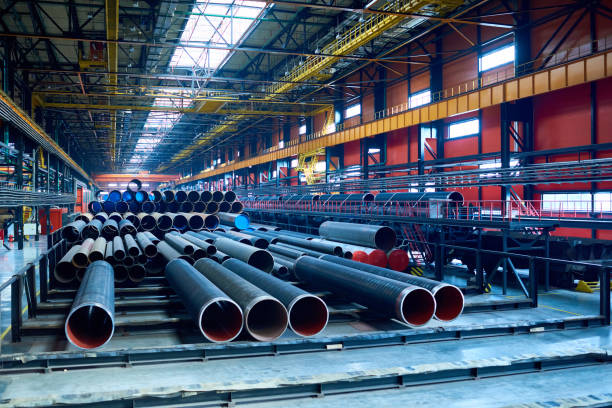Advanced Steel Fabrication Melbourne: Building the Future Today
Wiki Article
Ingenious Fads in Steel Fabrication: Enhancing Resilience and Accuracy
In the realm of steel fabrication, the pursuit of durability and precision has actually led to a wave of innovative fads that are improving the industry. These patterns are not just shaping the existing yet likewise laying the foundation for the future of steel manufacture, assuring more improvements in resilience and accuracy.Advanced Welding Technologies
In the realm of steel manufacture, the adoption of cutting-edge welding innovations has dramatically transformed the industry's technique to achieving superior top quality and precision in architectural welds. Advanced welding innovations, such as laser beam welding and friction mix welding, have emerged as game-changers in the field. By leveraging these innovative welding methods, steel fabricators can boost the toughness, strength, and precision of their architectural welds, meeting the increasingly requiring requirements of contemporary building and construction projects.Robot Automation in Manufacture
Accepting robot automation has ended up being a keystone of modern-day steel manufacture methods, simplifying processes and improving effectiveness throughout the sector. Robotics are transforming the method steel elements are manufactured, providing unparalleled precision and speed while reducing human error. These automated systems can take care of repetitive tasks with constant accuracy, resulting in greater high quality final product.One secret advantage of robotic automation in steel construction is the ability to work around the clock without tiredness, substantially boosting manufacturing output. This continuous operation minimizes downtime and accelerates project timelines, ultimately saving expenses for makers. Furthermore, robots can be configured to execute detailed jobs that might be unsafe or challenging for human workers, boosting safety and security in the office.
Moreover, robot automation enables seamless assimilation with various other electronic innovations, such as computer-aided layout (CAD) software and Web of Points (IoT) systems (steel fabricators melbourne). This interconnected strategy boosts communication between different phases of manufacture, optimizing process and making certain real-time monitoring and control. As the steel construction market proceeds to evolve, robotic automation sticks out as a transformative pressure driving efficiency and precision in producing procedures

High-Strength Alloy Advancement
The advancement of high-strength alloy development in steel construction is improving the sector's strategy to boosting product resilience and performance. High-strength alloys are engineered to exhibit premium mechanical residential properties, such as boosted tensile toughness, durability, and rust resistance contrasted to traditional steel qualities. By incorporating these innovative alloys right into manufacture procedures, producers can generate elements that hold up against greater anxiety degrees and harsh environments, resulting in even more durable and trustworthy final result.One trick benefit of high-strength alloy development is the ability to reduce material thickness without jeopardizing architectural stability. This not only results in lighter-weight parts but likewise adds to cost financial savings and enhanced efficiency in manufacture and assembly processes. The boosted strength-to-weight ratio of these alloys permits for the design and construction why not find out more of frameworks with higher load-bearing capabilities while minimizing general weight.
3D Modeling and Simulation Software
Advancements in steel manufacture processes have actually been considerably thrust by the combination of cutting-edge 3D modeling and simulation software application devices. These tools enable producers to create detailed online versions of their projects, enabling them to envision the final product with precision before any type of physical job starts. By imitating various anxiety variables, environmental problems, and architectural lots, fabricators can optimize styles for boosted resilience and efficiency. Furthermore, 3D modeling and simulation software program simplify the production process by determining possible concerns at an early stage, reducing the requirement for expensive rework and lessening material waste.
Lasting Practices in Steel Production
Including sustainable techniques right into steel manufacturing processes is important for minimizing environmental influence and making sure long-term resource schedule. One key lasting method is the fostering of energy-efficient innovations to lower greenhouse gas discharges during the steel manufacturing procedure. This includes utilizing eco-friendly energy sources, such as solar or wind power, to power steel plants and implementing energy-efficient devices to maximize energy usage.One more essential facet of sustainable steel production is the liable sourcing of basic materials. This includes making sure that the iron ore and other sources used in steelmaking are acquired from ecologically friendly and honest resources. By advertising openness in the supply chain and sticking to strict environmental standards, steel makers can decrease the negative impacts of resource extraction on neighborhood environments and areas.

Verdict
Finally, the ingenious trends in steel fabrication such as advanced welding technologies, robot automation, high-strength alloy advancement, 3D modeling and simulation software, and lasting methods are improving the durability and precision of steel items. These innovations are changing the steel construction industry by boosting performance, sustainability, and quality. It is clear that the future of steel construction depends on embracing these innovative technologies to fulfill the demands of modern-day construction and production industries.In the world of steel fabrication, the quest of resilience and accuracy has led to a wave of innovative fads that are reshaping the market.In the world of steel fabrication, the fostering of cutting-edge welding technologies has actually considerably changed the industry's technique to attaining exceptional high quality and accuracy in structural welds. As the steel construction sector proceeds to develop, robotic automation stands out as a transformative pressure driving performance and precision in producing procedures.
In addition, reusing and recycling steel scrap and waste materials play a substantial duty in enhancing the sustainability of steel production. metal fabrication melbourne.In conclusion, the ingenious fads in steel fabrication such as advanced Web Site welding technologies, robot automation, high-strength alloy advancement, 3D modeling and simulation software application, and sustainable techniques are improving the sturdiness and precision of steel products
Report this wiki page